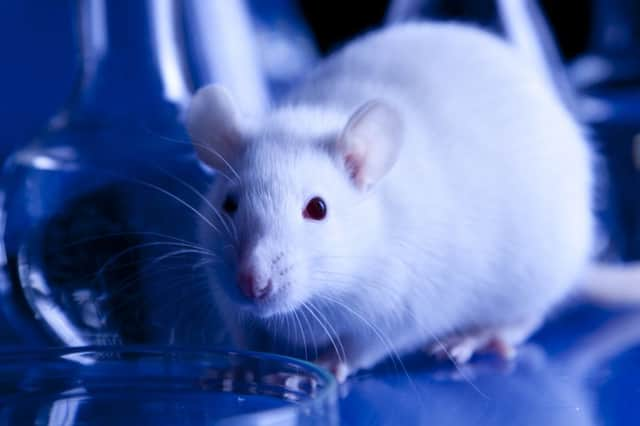Scottish universities criticised for animal tests


The British Union for the Abolition of Vivisection (BUAV) highlighted a number of cases in which it claims animals were subjected to needlessly cruel experimentation.
Nearly 620,000 animals were used in 613,000 experiments carried out Scotland in 2013 – the majority of them carried out in universities.
Advertisement
Hide AdAdvertisement
Hide AdThe figure represents a small decrease (0.5 per cent) on the total number used in 2012, but BUAV, which has campaigned peacefully against vivisection since 1949, said many of the experiments were unnecessary.
Dr Katy Taylor, BUAV’s head of science, said: “We are shocked that such cruel and pointless experiments are being permitted and publicly funded in Scotland.
“The consequences of stressful early events, such as a poor childhood, are well appreciated in humans. The way humans respond to stressful situations is so complex and varied that it simply cannot be mimicked in these crude, controlled animal tests. Money is being wasted on these cruel experiments that could have been diverted instead to carry out humane and relevant research that will be of benefit to humans.”
According to figures released by the Home Office, 619,798 animals were used in regulated procedures in 2013 under the Animals (Scientific Procedures) Act. The majority (62 per cent) were performed without anaesthesia.
More than 400,000 of the animals were mice, but sheep, horses, cats and dogs were also used. In 2010, the UK government committed itself to reduce the use of animals in scientific research.
The BUAV highlighted an experiment carried out at Edinburgh University, where researchers studying the impact of stress on early life subjected rats to a series of tests to determine their fear and stress responses. At the end of the research, which was published this year in the journal Hippocampus, the rodents were killed by a rising concentration of carbon dioxide. The researchers said the study was carried out in line with guidelines issued by the Home Office and the EU.
The BUAV has previously highlighted an experiment carried out at St Andrews University, where captured grey seals were played loud sounds to test their startle reflexes.
According to the campaigners, the research, which was published in the journal BMC Neuroscience, saw seals exposed to sounds of 170-174dB, louder than a firework going off three feet away.
Advertisement
Hide AdAdvertisement
Hide AdThe BUAV said the research had been unlicensed after the Home Office admitted it had not been “clear cut” whether the exposure to sound met the threshold for licensing under the Animals (Scientific Procedures) Act.
A University of Edinburgh spokesperson said: “Research using animals has played and continues to play a key role in the advancement of medical, biological and veterinary science. It has made a vital contribution towards the understanding, prevention, treatment and cure of a range of major health problems, including cancer, heart disease and psychiatric disorders.
“The University of Edinburgh uses animals in research programmes only when their use is justified on scientific, ethical and legal grounds, and when no alternatives are available. All such work is strictly regulated and carried out under licences, which are reviewed and approved by the Home Office and are issued only if the potential benefits of the work are likely to outweigh the effects on the animals concerned.”
A spokesperson for the University of St Andrews said: “All research on wild animals that is conducted at St Andrews is designed to protect and help wild populations. Our research with seals in the wild is helping to develop new acoustic deterrent devices. The precise purpose of this is to prevent the deaths of seals shot by the fish farming industry every year and to avoid negative effects on the animals caused by existing devices, which include hearing damage and keeping dolphins, porpoise and seals out of their natural feeding grounds.
“Without the development of a humane deterrent it is inevitable wild marine mammals will continue to suffer unnecessarily. It is unfortunate BUAV has not been open and honest about this in their pejorative presentation of our research.”